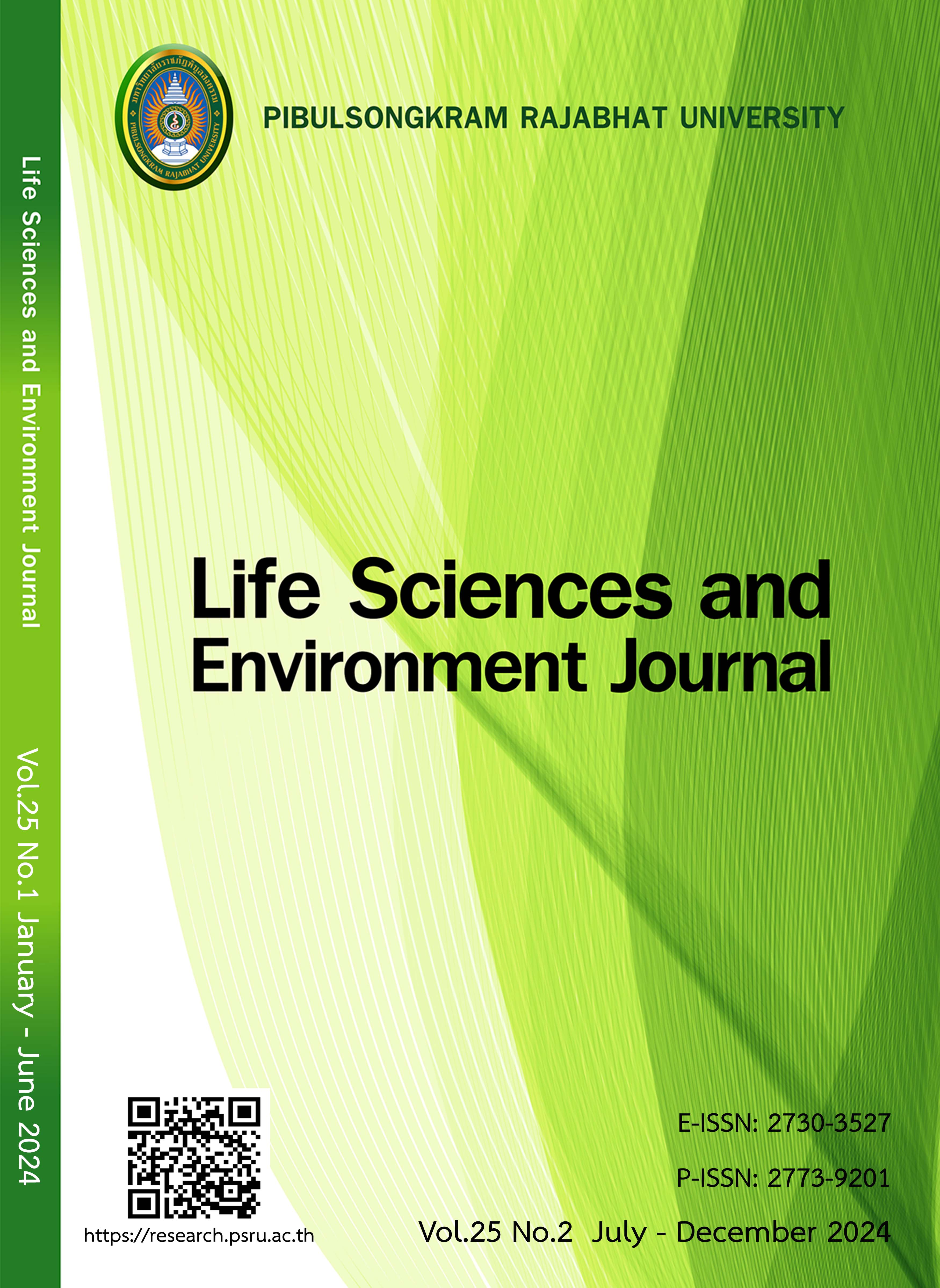SYNTHESIS OF POLYDIACETYLENE BY MICROWAVE-ASSISTED FOR SURFACTANT DETECTION APPLICATION IN THE ENVIRONMENT
DOI:
https://doi.org/10.14456/lsej.2024.22Keywords:
polydiacetylene, surfactants, microwave-assisted synthesisAbstract
This research focuses on the synthesis of polydiacetylene (PDA) solutions using microwave-assisted method for detecting surfactant contamination in the environment. The PDA was prepared through the solution-mixing method (SMM) combined with microwave synthesis at 80°C, using 1000 watts of power for varying durations of 5, 15, 30, and 60 minutes. It was observed that a high-concentration solution with clear morphology was achieved within just 5 minutes of microwave exposure. The exposure time significantly impacted the crystalline structure and molecular interactions, as analyzed by XRD and FT-IR, in alignment with the thin-film hydration method (TFHM).
The microwave-assisted SMM simplified the synthesis process and enhanced safety by eliminating the need for volatile chemical evaporation during fabrication. Additionally, the study examined the colorimetric response of PDA to the cationic surfactant CTAB. The concentration of CTAB that induced a clear color change from blue to yellow was 0.22, 0.45, 0.67, and 1.12 mg/L for synthesis times of 5, 15, 30, and 60 minutes, respectively. The results indicate that shorter synthesis times lead to faster color transitions. This study provides valuable insights into the application of microwave-assisted PDA synthesis for monitoring surfactant contamination in the environment.
References
Al-Gaashani R, Radiman S, Tabet N, Daud AR. Effect of microwave power on the morphology and optical property of zinc oxide nano-structures prepared via a microwave-assisted aqueous solution method. Materials Chemistry and Physics 2011;125(3):846-852.
Beliktay G, Shaikh T, Koca E, Cingil HE. Effect of UV irradiation time and headgroup interactions on the reversible colorimetric pH response of polydiacetylene assemblies. ACS Omega 2023;8(40): 37213-37224.
Brahma S, Liu CP, Shivashankar SA. Microwave irradiation assisted, one pot synthesis of simple and complex metal oxide nanoparticles: a general approach. Journal of Physics D: Applied Physics 2017;50(40):40LT03.
Chanakul A, Saymung R, Seetha S, Traiphol R, Traiphol N. Solution-mixing method for large-scale production of reversible thermochromic and acid/base-colorimetric sensors. Colloids and Surfaces A: Physicochemical and Engineering Aspects 2021;615:126241.
Charoenthai N, Pattanatornchai T, Wacharasindhu S, Sukwattanasinitt M, Traiphol R. Roles of head group architecture and side chain length on colorimetric response of polydiacetylene vesicles to temperature, ethanol and pH. Colloid and interface Science 2011;360(2):565-573.
Das A, Banik BK. Foundational principles of microwave chemistry. In: Elsevier eBooks.; 2021:3-26.
De La Hoz A, Díaz‐Ortiz Á, Prieto P. Microwave-Assisted Green Organic Synthesis. In: The Royal Society of Chemistry eBooks; 2016:1-33.
Fu L, Hou C. A polydiacetylene-based smart cellulose aerogel functionalized by ZnO/MoS2 heterojunction for simultaneous visual detection and photocatalytic degradation of gaseous VOCs. Separation and Purification Technology 2023;314:123512.
Gaba M, Dhingra N. Microwave chemistry: general features and applications. Indian Journal of Pharmaceutical Education and Research 2011; 45(2):175-183.
Geetanjali, Savan R. Microwave-assisted organic synthesis in water. Current Microwave Chemistry 2021;8(2):117-127.
Ge M, He Z, Song Z. Polydiacetylene/organic magadiite nanocomposite film with stable reversible structure and reversible thermochromism. Journal of Polymer Research 2022;29(9):382.
Hussain S, Deb R, Suklabaidya S, Bhattacharjee D, Hussain SA. Polydiacetylene a unique material to design biosensors. Materials Today: Proceedings 2022;65:2765-2772.
Kawamura S. Integrated design and operation of water treatment facilities. 2nd Edition, John Wiley & Sons: Inc. New York; 2000.
Khanantong C, Charoenthai N, Phuangkaew T, Kielar F, Traiphol N, Traiphol R. Phase transition, structure and color-transition behaviors of monocarboxylic diacetylene and polydiacetylene assemblies: The opposite effects of alkyl chain length. Colloids and Surfaces A: Physicochemical and Engineering Aspects 2018;553:337-348.
Khanantong C, Srinopkun T, Boonmak T, Siriboon J. One-pot microwave-assisted approach of polydiacetylene/zinc oxide nanocomposite for reversible thermochromic. Journal of Metals, Materials and Minerals 2024;34(2):1922.
Lee KM, Moon J, Jeon H, Chen X, Kim HJ, Kim S, Kim SJ. al el. Diverse colorimetric changes of polydiacetylenes with cationic surfactants and their mechanistic studies. Journal of Materials Chemistry 2011;21(43):17160.
Nguyen LH, Naficy S, McConchie R, Dehghani F, Chandrawati R. Polydiacetylene-based sensors to detect food spoilage at low temperatures. Journal of Materials Chemistry C 2019;7(7):1919-1926.
Pankaew A, Traiphol N, Traiphol R. Tuning the sensitivity of polydiacetylene-based colorimetric sensors to UV light and cationic surfactant by co-assembling with various polymers. Colloids and Surfaces A: Physicochemical and Engineering Aspects 2021;608:125626.
Pattanatornchai T, Charoenthai N, Wacharasindhu S, Sukwattanasinitt M, Traiphol R. Control over the color transition behavior of polydiacetylene vesicles using different alcohols. Journal of Colloid and Interface Science 2013;391:45-53.
Qian X, Städler B. Recent developments in Polydiacetylene-Based sensors. Chemistry of Materials 2019;31(4):1196-1222.
Saymung R, Traiphol N, Traiphol R. Promoting self-assembly and synthesis of color-responsive polydiacetylenes using mixed water-organic solvents: Effects of solvent composition, structure, and incubation temperature. Colloids and Surfaces A: Physicochemical and Engineering Aspects 2021;626:127046.
Traiphol N, Chanakul A, Kamphan A, Traiphol R. Role of Zn2+ ion on the formation of reversible thermochromic polydiacetylene/zinc oxide nanocomposites. Thin Solid Films. 2017; 622;122-129.
Tjandra AD, Pham AH, Chandrawati R. Polydiacetylene-Based sensors to detect volatile organic compounds. Chemistry of Materials 2022;34(7):2853-2876.
Weston M, Tjandra AD, Chandrawati R. Tuning chromatic response, sensitivity, and specificity of polydiacetylene-based sensors. Polymer Chemistry 2020;11(2):166-183.
Wu D, Zhang R, Lin G. Molecular-level design of excellent reversible thermochromic polydiacetylene materials with the simultaneous enhancement of multiple performances. Materials Chemistry Frontiers 2021;5(18):7041-7050.
Yao S, Li J, Jiang L. Effect of amphiphilic molecules upon chromatic transitions of polydiacetylene vesicles in aqueous solutions. Colloids and Surfaces B: Biointerfaces 2004;39(3):113-118.
Downloads
Published
How to Cite
Issue
Section
License
Copyright (c) 2024 Life Sciences and Environment Journal

This work is licensed under a Creative Commons Attribution-NonCommercial-NoDerivatives 4.0 International License.
Each article is copyrighted © by its author(s) and is published under license from the author(s).










